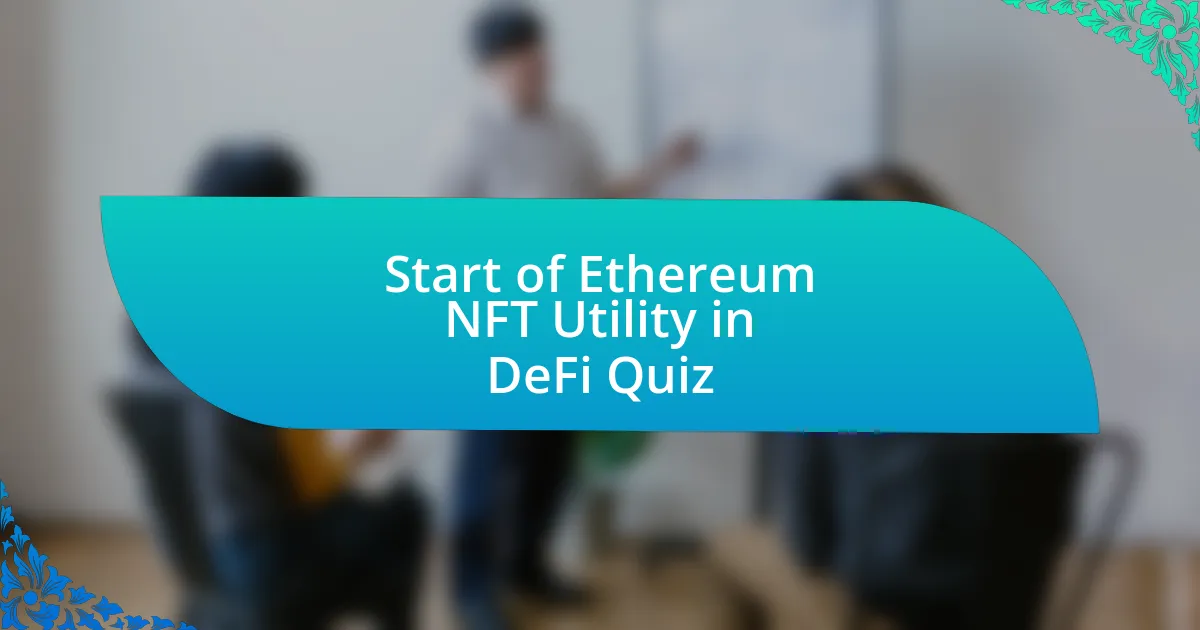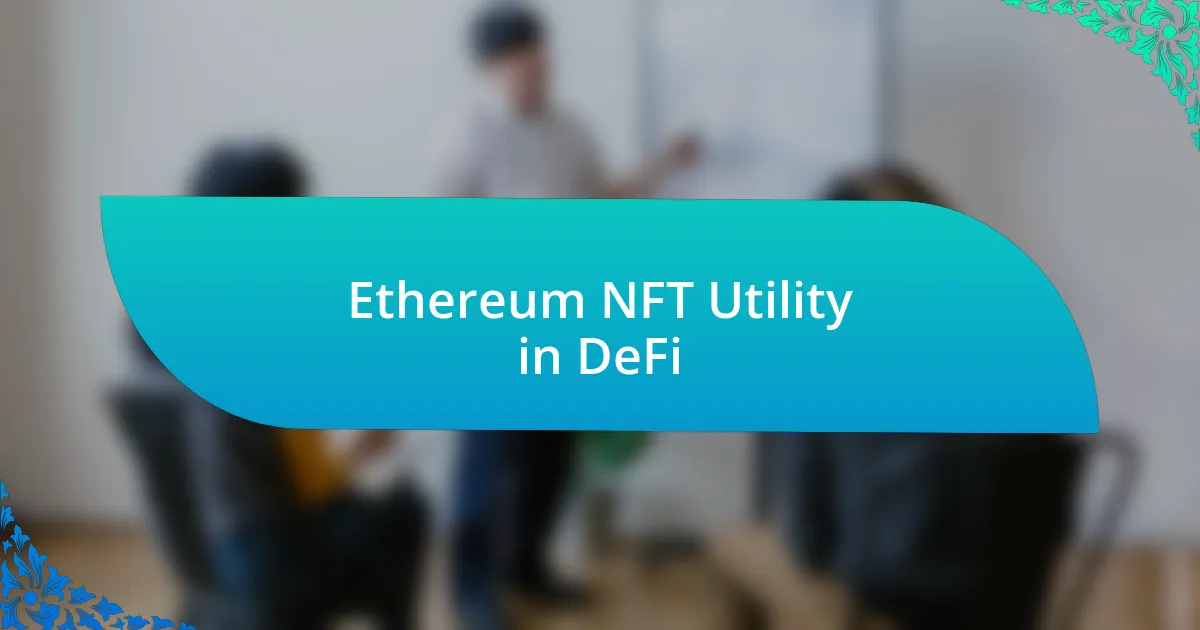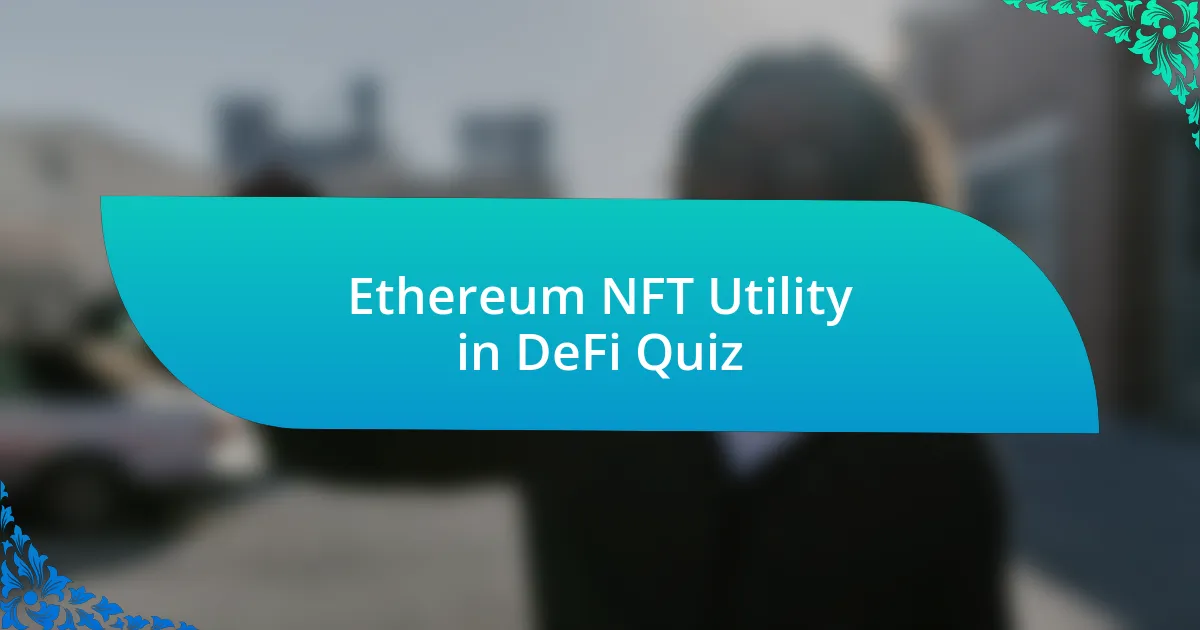
Start of Ethereum NFT Utility in DeFi Quiz
1. What is Ethereum NFT utility in DeFi?
- Ethereum NFT utility in DeFi refers to using NFTs as collectibles for social status and art appreciation.
- Ethereum NFT utility in DeFi involves integrating NFTs into decentralized finance (DeFi) products, enabling new financial services and increasing the yields and liquidity of digital assets.
- Ethereum NFT utility in DeFi revolves around gaming applications with no relevance to finance.
- Ethereum NFT utility in DeFi is only about creating virtual assets without any financial benefit.
2. How do NFTs interact with DeFi protocols?
- NFTs interact with DeFi protocols by representing liquidity positions, allowing for yield-bearing instruments, and facilitating fractionalization and lending services.
- NFTs decrease the liquidity in DeFi by making transactions more complicated.
- NFTs are completely different from DeFi and do not share any common functionality.
- NFTs can only be used for digital art and cannot interact with DeFi protocols.
3. What is Uniswap v3`s role in NFT utility?
- Uniswap v3 prohibits the use of NFTs in any trading activities.
- Uniswap v3 is a platform that only supports art NFTs and not utility.
- Uniswap v3 exclusively trades traditional assets without using NFTs.
- Uniswap v3 allows users to represent liquidity positions as NFTs, enabling more trades and higher income from swapping fees.
4. How do NFTs contribute to liquidity in DeFi?
- NFTs reduce demand for fungible tokens, thus lowering liquidity in DeFi markets.
- NFTs contribute to liquidity by making digital-asset ownership transferable and creating new financial services that weren`t possible before.
- NFTs solely serve as collectibles and do not impact financial services in DeFi.
- NFTs create static digital assets that do not contribute to liquidity or trading volume.
5. What is Charged Particles` role in NFT utility?
- Charged Particles supports yield-bearing instruments enclosed in NFTs.
- Charged Particles converts NFTs into fungible tokens.
- Charged Particles limits NFT use to digital art only.
- Charged Particles creates NFTs without any functionality.
6. How do oracles support NFT collaterals in DeFi?
- Oracles verify NFT ownership and authenticity.
- Oracles disconnect NFTs from blockchain.
- Oracles create new types of NFTs.
- Oracles reduce the value of NFT collaterals.
7. What is fractional.art`s utility in DeFi?
- Fractional.art offers extensive trading volumes for high-value NFTs, making it a top choice for collectors.
- Fractional.art enables the creation of unique NFTs for gaming environments, enhancing player experiences.
- Fractional.art serves as a platform for artists to auction their work without any fees.
- Fractional.art provides the ability to own fractional pieces of popular NFT art, allowing smaller holders access to these markets.
8. How does Yield Guild Games (YGG) integrate NFTs with DeFi?
- YGG integrates NFTs by restricting access and limiting players to traditional game mechanics.
- YGG integrates NFTs by focusing only on creating digital collectibles that cannot be traded.
- YGG integrates NFTs with DeFi by allowing access to fractionalization and DeFi for gamers, enabling them to earn rewards and participate in gaming ecosystems.
- YGG uses NFTs solely for art collection without any DeFi functionalities.
9. What is NFTx`s role in creating and trading NFT-backed tokens?
- NFTx gives the ability to create, mint, and trade NFT-backed tokens, providing a platform for tokenization and trading of digital assets.
- NFTx is primarily a social media platform for NFT creators.
- NFTx enables users to create and sell physical assets online easily.
- NFTx allows only for the storage of NFTs without any trading function.
10. How does PWN Finance use NFTs in peer-to-peer loans?
- PWN Finance uses NFTs as collateral for peer-to-peer loans.
- PWN Finance leverages NFTs for exclusive access to social media platforms.
- PWN Finance utilizes NFTs for trading purposes in the stock market.
- PWN Finance employs NFTs as decorative assets in virtual reality.
11. What is the significance of representing liquidity positions as NFTs?
- Representing liquidity positions as NFTs restricts digital-asset ownership.
- Representing liquidity positions as NFTs increases fees for users.
- Representing liquidity positions as NFTs decreases trading opportunities.
- Representing liquidity positions as NFTs creates a secondary market for trades.
12. How do yield multipliers enhance NFT utility in DeFi?
- Yield multipliers enhance NFT utility by allowing yield-bearing instruments to continue generating yield even when encased in non-fungible tokens.
- Yield multipliers limit the resale value of NFTs within DeFi markets.
- Yield multipliers reduce the transaction fees associated with NFTs in DeFi applications.
- Yield multipliers enable NFTs to function as standalone assets without needing DeFi integration.
13. What is the role of XP.NETWORK in bridging Leptons between Ethereum and Polygon?
- XP.NETWORK solely focuses on Ethereum transactions.
- XP.NETWORK simplifies token minting on blockchain.
- XP.NETWORK helps bridge Leptons across networks.
- XP.NETWORK promotes NFT art sales.
14. How does DeFi make NFT marketplaces more accessible?
- DeFi compels all NFT transactions to occur on a single platform, reducing accessibility for users.
- DeFi focuses solely on traditional cryptocurrencies, neglecting the needs of NFT marketplaces.
- DeFi limits the number of NFTs available for purchase, making them less accessible to buyers.
- DeFi makes NFT marketplaces more accessible by providing infrastructure that increases liquidity and makes it easier for users to buy and sell NFTs.
15. What is the relationship between NFTs and DeFi in terms of liquidity?
- NFTs are only collectibles, while DeFi manages high-frequency trading.
- NFTs represent physical assets, and DeFi operates traditional banking.
- NFTs allow for easy transfer of asset ownership while DeFi enhances asset liquidity.
- NFTs create exclusive art platforms, and DeFi reduces art investment risks.
16. How do NFTs facilitate new financial services in DeFi?
- NFTs facilitate new financial services in DeFi by solely focusing on art creation and ignoring financial instruments.
- NFTs facilitate new financial services in DeFi by increasing the sale price of digital assets through bidding wars.
- NFTs facilitate new financial services in DeFi by locking digital assets away without any user benefits.
- NFTs facilitate new financial services in DeFi by enabling tokenization, fractionalization, and lending services, which were not possible before.
17. What is the significance of using smart contracts for NFTs in DeFi?
- Smart contracts allow for anonymous transactions and ownership.
- Smart contracts ensure immutable ownership and programmability.
- Smart contracts reduce transaction fees and increase NFT accessibility.
- Smart contracts guarantee instant transfer of NFTs without delays.
18. How do NFTs contribute to the accessibility of DeFi?
- NFTs contribute to accessibility by allowing anyone to create an NFT collection, making it easier for new users to participate in decentralized finance.
- NFTs diminish DeFi accessibility by introducing high transaction fees that deter users.
- NFTs restrict access to DeFi by requiring technical expertise, limiting participation.
- NFTs complicate DeFi transactions, making them less accessible for average users.
19. What is the role of OpenSea in trading liquidity NFTs?
- OpenSea only allows trading of traditional cryptocurrencies without NFTs.
- OpenSea restricts the trading of liquidity NFTs to select users only.
- OpenSea does not support any NFT transactions related to liquidity.
- OpenSea features many liquidity NFTs but has seen limited trading activity, indicating a need for a thriving secondary market for liquidity NFTs.
20. How does the integration of DeFi with NFTs help solidify floor prices?
- The integration of DeFi with NFTs reduces trading activity, making it easier for owners to sell their assets quickly.
- The integration of DeFi with NFTs helps solidify floor prices by providing value to owners through lending services and yield-bearing instruments, reducing the incentive to sell.
- The integration of DeFi with NFTs increases speculation by enhancing the market volatility of digital assets.
- The integration of DeFi with NFTs leads to higher transaction fees, which deters users from buying and selling NFTs.
21. What is the impact of the 2021 NFT hype on market dynamics?
- The 2021 NFT hype simplified buying processes, making it easier for everyone to invest in digital art.
- The 2021 NFT hype caused traditional finance to become irrelevant, fully replaced by crypto assets.
- The 2021 NFT hype led to a surge in speculators, creating selling pressure, especially during airdrops and launch days, which made it hard for new projects to build communities.
- The 2021 NFT hype resulted in a complete market collapse, erasing all values for digital assets.
22. How does DeFi lending support NFTs?
- DeFi lending exclusively focuses on traditional currencies, ignoring NFTs.
- DeFi lending reduces the value of NFTs by creating excess supply.
- DeFi lending supports NFTs by allowing owners to use them as collateral for loans.
- DeFi lending limits the use of NFTs only to gaming applications.
23. What is the significance of fractionalization in NFTs?
- Fractionalization in NFTs allows smaller holders to access markets by owning fractional pieces of popular NFT art, increasing accessibility and liquidity.
- Fractionalization makes NFTs non-fungible, leading to fewer buyers.
- Fractionalization requires complete ownership of an NFT for trading.
- Fractionalization destroys the value of NFTs by dividing them into smaller parts.
24. How do NFTs with utility differ from basic NFTs?
- Utility NFTs can only be used in specific video games.
- All NFTs have the same value regardless of utility.
- Basic NFTs are only a digital representation of ownership.
- NFTs with utility offer additional financial benefits and services.
25. What is the role of Charged Particles in supporting yield-bearing instruments?
- Charged Particles prevents yield in NFTs, making them less valuable and limiting their potential.
- Charged Particles restricts yield-bearing instruments to fungible tokens only, not allowing any integration with NFTs.
- Charged Particles is solely focused on minting NFTs without regard for yield-bearing functionalities.
- Charged Particles supports yield-bearing instruments by allowing them to bear yield even when encased in non-fungible tokens, ensuring continuous revenue generation.
26. How does XP.NETWORK`s partnership with Charged Particles enhance NFT utility?
- XP.NETWORK limits NFT transfers to one blockchain.
- XP.NETWORK reduces NFT creation costs.
- XP.NETWORK eliminates all transaction fees for NFTs.
- XP.NETWORK bridges Leptons between blockchains.
27. What is the relationship between NFTs and DeFi in terms of market accessibility?
- DeFi creates barriers to entry for NFT marketplaces due to high fees.
- DeFi has no connection to NFTs, so market accessibility remains unchanged.
- DeFi limits NFT accessibility by requiring technical knowledge to participate.
- DeFi infrastructure enhances NFT marketplace accessibility through increased liquidity.
28. How do NFTs with utility attract new buyers?
- NFTs with utility attract new buyers by providing value through lending services and yield-bearing instruments.
- NFTs with utility offer no additional features compared to standard NFTs.
- NFTs with utility make it harder for buyers to understand their value in the market.
- NFTs with utility only focus on art and collectibles without financial benefits.
29. What is the significance of using oracles in NFT collaterals?
- They increase transaction speeds.
- They reduce minting costs.
- They eliminate gas fees entirely.
- They verify ownership and authenticity.
30. What is the impact of EIP-1559 on low-value NFT transactions?
- EIP-1559 eliminates gas fees completely, allowing for free low-value NFT transactions.
- EIP-1559 reduces transaction fees, making it more feasible for low-value NFT transactions, which was previously hindered by high gas fees.
- EIP-1559 increases gas fees, discouraging low-value NFT transactions due to higher costs.
- EIP-1559 has no impact on transaction fees for low-value NFT transactions, leaving costs unchanged.

Quiz Completed: Congratulations!
You’ve successfully completed the quiz on Ethereum NFT Utility in DeFi! We hope you found the questions engaging and the process enjoyable. Testing your knowledge in this rapidly evolving area of blockchain technology can be both fun and educational. This quiz aimed to enhance your understanding of how NFTs are being utilized in decentralized finance, bridging two incredible sectors of the crypto world.
From this quiz, you may have learned about the various ways NFTs can serve practical purposes in DeFi applications. Concepts like collateralized loans, liquidity pools, and unique tokenization methods were covered. Gaining insights into these topics empowers you to better comprehend the broader implications of NFTs beyond mere collectibles. You now have a foundation to delve deeper into the functionalities and benefits NFTs bring to the DeFi landscape.
As you move forward, we invite you to explore the next section on this page. Here, you will find in-depth information regarding the utility of Ethereum NFTs in DeFi. This resource will further expand your knowledge and might inspire you to think creatively about how NFTs can reshape financial interactions. Continue your learning journey and discover the exciting possibilities that lie ahead in this innovative space!

Ethereum NFT Utility in DeFi
Overview of Ethereum NFTs in Decentralized Finance (DeFi)
Ethereum NFTs (Non-Fungible Tokens) are unique digital assets built on the Ethereum blockchain. They represent ownership of a specific item or piece of content. In the context of DeFi, these NFTs can serve various roles, enhancing financial services by providing unique collateral options. This function differentiates them from traditional cryptocurrencies and allows for innovative use cases within financial applications. Their programmable nature enables integration with decentralized applications, expanding their utility in DeFi ecosystems.
Role of NFTs as Collateral in DeFi Lending Platforms
In DeFi lending platforms, NFTs can act as collateral for loans. Borrowers can use their NFTs to secure loans, allowing them to access liquidity without selling their assets. This process involves evaluating the NFT’s market value to determine loan amounts. Platforms such as NFTfi facilitate this by allowing users to lock their NFTs in exchange for a stablecoin loan. This integration enhances liquidity in the NFT market and fosters a more dynamic borrowing environment.
NFT Liquidation Mechanisms in DeFi Protocols
NFT liquidation mechanisms are critical for managing risk in DeFi lending. When borrowers fail to repay their loans, protocols may liquidate their NFTs to recover lost funds. Unlike traditional assets, NFTs require specific appraisal methods due to their uniqueness. DeFi platforms have developed protocols to automate this process. For instance, they use price oracles to value NFTs, enabling timely liquidation and minimizing losses for lenders. This feature protects funds and maintains the integrity of lending systems.
Yield Farming with NFTs in DeFi
Yield farming involves using assets to generate returns in DeFi. NFTs can participate in yield farming by allowing their holders to stake them in various protocols. Users earn passive income through rewards like tokens or transaction fees. Some platforms enable users to pool their NFTs, enhancing the yield potential. This practice incentivizes NFT usage and contributes to a more robust DeFi ecosystem. Overall, it bridges the gap between NFTs and traditional yield strategies.
Impact of NFTs on DeFi Governance Models
NFTs influence governance models in DeFi by introducing unique voting rights tied to asset ownership. Some protocols grant NFT holders voting power on key decisions, such as protocol upgrades or treasury management. This model encourages active participation from NFT owners, aligning their interests with the platform’s success. As governance structures evolve, NFTs can enhance community engagement and contribute to decentralized decision-making processes. Their distinctiveness fosters a participatory culture in DeFi governance.
What is Ethereum NFT utility in DeFi?
Ethereum NFT utility in DeFi refers to the application of non-fungible tokens (NFTs) within decentralized finance (DeFi) ecosystems. NFTs can represent unique assets, collateral, or access rights in DeFi protocols. For instance, NFTs can act as collateral for loans or enable governance rights within decentralized applications. The growing integration of NFTs in DeFi enhances liquidity and participation in various financial services.
How do NFTs enhance DeFi protocols?
NFTs enhance DeFi protocols by providing unique identificable assets that can be used for collateral, staking, and governance mechanisms. This enables users to utilize their NFTs to access loans, yield farming opportunities, and voting rights in governance decisions. The use of NFTs introduces an innovative layer of value, allowing for novel financial products and diverse investment strategies within the DeFi space.
Where can users find Ethereum NFTs for DeFi purposes?
Users can find Ethereum NFTs for DeFi purposes on various marketplaces such as OpenSea, Rarible, and Foundation. These platforms facilitate the buying, selling, and trading of NFTs that may have DeFi utility. Additionally, projects like Aavegotchi and Illuvium integrate NFT functionality directly with DeFi protocols, allowing users to engage with NFTs in financial applications.
When did the integration of NFTs into DeFi begin gaining traction?
The integration of NFTs into DeFi began gaining traction in 2020. This period marked the rise of various NFT marketplaces and the increasing popularity of unique digital assets. By late 2020 and into 2021, projects started to explore how NFTs could serve as collateral and provide access to various financial services, leading to advancements in hybrid DeFi-NFT applications.
Who are the major players in the Ethereum NFT DeFi space?
Major players in the Ethereum NFT DeFi space include projects like Aavegotchi, which combines DeFi staking with NFT gaming, and Nifty Gateway, which showcases NFT drops linked to financial utilities. Other significant contributors are platforms like Rarible and OpenSea, which have started incorporating DeFi functionalities into their services. These entities are pivotal in shaping the future of NFTs within the DeFi landscape.

